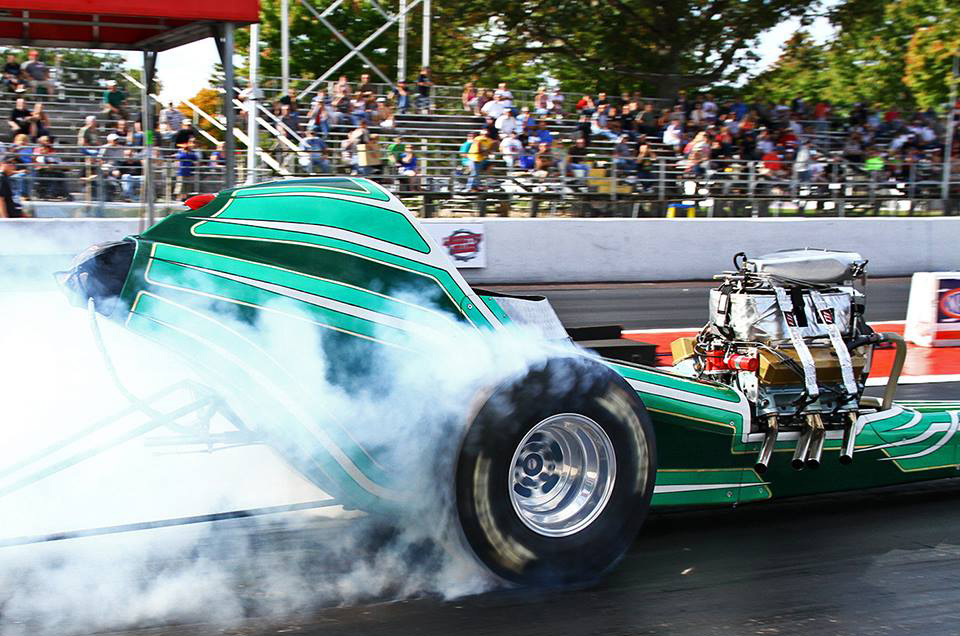Powder Coat Part 7: Powder Coating Equipment and Powders
Click image to see larger picture
So now let’s talk a little bit about powder coat equipment. Just like air compressors and filtration there are many levels of powder coat equipment from expensive to very affordable.
There are basically two different powder coat units and a full range of prices for both.
Before we talk about the differences, I would make the recommendation that whatever system you get have the trigger for the system as part of the gun.
Some of the less expensive guns have a separate trigger and that means you have to carry two things around while powder coating. Also being able to vary the amount of voltage and air flow the gun produces will help when it comes to applying multiple layers of powder and when applying powder in hard to coat areas (I will talk about this when we get to the actual process of apply powder – we will get there).
The first type of unit is a powder coat gun with the powder hopper attached to the gun. These are generally less expensive. They can deliver as good a finished product as the most expensive guns with remote hopper guns.
I see their limitations as:
> The amount of objects you can spray without having to reload the hopper.
>> If you are only doing one object and it is not very large, this is not be a limitation.
>> Of note here is that powder in a hopper is not the same as paint in a spray gun. The amount of powder coming out of the nozzle changes as the amount of powder that remains in the hopper changes. When it is full, and you never fill it all the way up as you would get way to much powder coming out of the nozzle, more powder comes out of the nozzle.
>> As the amount of powder in the hopper decreases, less powder comes out of the nozzle
>> Unlike a spray gun for paint, a small amount of powder coming out of the nozzle will not produce a “dry” finish. It will just take that much longer to build up the correct thickness of powder on the object being coated.
>> It will get to a point that even though there is powder in the hopper you are not getting enough powder out of the nozzle to coat your object.
>> The solution is to stop and add powder to the hopper. Stopping in the middle of powder coating an object does not affect the quality of the finished product.
> A second drawback is having to hold the weight of the hopper in your hand as the hopper is attached to the gun. Even a pound of powder will get heavy after a while. Try holding a pound weight in an outstretched hand and see how long you last.
> The maneuverability of the gun with a hopper attached is limited. With the hopper attached to the gun, the orientation of the gun to the object becomes important. For instance, if the gun is held upside down the powder will not flow correctly.
> As the hopper that screws to the gun is a “specialty” item, you might only have one or two hoppers so you would have to clean the hopper to change colors.
I see their advantages as:
> They are less expensive than remote hopper units
> Color changes are simple with little wasted powder
> With patience, they can do everything a more expensive unit can do
> They do not require as permanent of a setup as a gun with an external hopper
> Air flow can be regulated with the addition of an air pressure regulator
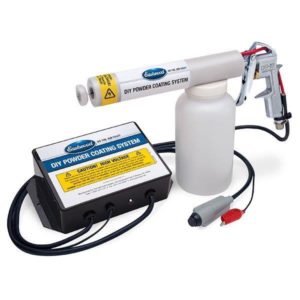 This is an example of a less expensive unit that has a separate trigger. It also does not allow you to adjust voltage levels. It sells for around $60.00
This is an example of a less expensive unit that has a separate trigger. It also does not allow you to adjust voltage levels. It sells for around $60.00
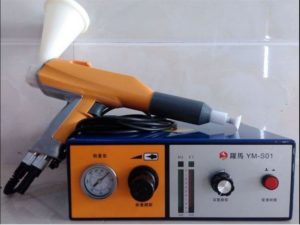 This is the other end of the spectrum of attached hoppers. It allows you to vary the amount of air pressure sent to the gun and also allows you to vary the voltage at the gun tip. It is very similar in appearance to my gun, however I have an external hopper. The cost of this gun is $400.00
This is the other end of the spectrum of attached hoppers. It allows you to vary the amount of air pressure sent to the gun and also allows you to vary the voltage at the gun tip. It is very similar in appearance to my gun, however I have an external hopper. The cost of this gun is $400.00
The second type of unit is a powder coat gun with an external hopper. These guns are generally more expensive and offer a greater degree of flexibility.
I see their limitations as:
> Require a more permanent set up
> Color changes are more difficult and tend to waste a small amount of powder
I see their advantages as:
> There is a wide range of equipment and prices allowing you to pick the options you need
> Generally both the voltage and the air flow are adjustable from the control unit
> The powder coat hopper size can really be any size. This means you can go for long periods of time without having to refill the hopper. It also means that the rate of flow of powder out of the tip of the gun does not fluctuate anywhere near as much as with the attached hopper to the gun.
> The trigger is general incorporated into the gun which leaves one hand free
> The gun is much lighter to handle
> The orientation of the gun makes no difference to the flow of the powder. This means you can come at an object from any angle and get the same rate of flow of powder.
> The control unit can be in a separate room and thereby not exposed to the application of powder
> The external hopper can be unique to the gun, and in the case of my gun, it was. What I did was cut off the top of the remote hopper and hot glued it to the lid of a quart paint gun. This made the lid of the remote hopper fit a readily available standard size container (quart paint cans). A quart can contains enough powder to complete four control arms. And with quart cans readily available, I have a can for each color that I stock.
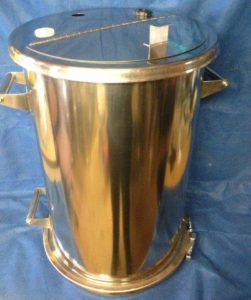 Just as an example, this is a 50 pound hopper that can be used with a remote hopper gun. You could run for days with this and not have to add powder. This would not be practical for a home shop because these units (remote hopper guns and control units) can run up into the thousands of dollars. If you are interested in this type of equipment, you need to do your own research.
Just as an example, this is a 50 pound hopper that can be used with a remote hopper gun. You could run for days with this and not have to add powder. This would not be practical for a home shop because these units (remote hopper guns and control units) can run up into the thousands of dollars. If you are interested in this type of equipment, you need to do your own research.
Let me show you my system.
I bought this system years ago and at the time it was twice as expensive as what it is today. Prices have come way down on this equipment. It was purchased from Columbia Coatings http://www.columbiacoatings.com/.
Mine is one of their cheapest units. I was looking for a remote hopper and this did the trick for me. It consists of three different pieces.
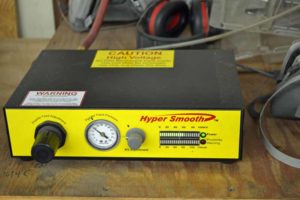 This is the control module. The control module has adjustments for both air flow and voltage and controls the voltage differential between the powder and the part. I have it sitting on a shelf just outside the room where I apply my powder.
This is the control module. The control module has adjustments for both air flow and voltage and controls the voltage differential between the powder and the part. I have it sitting on a shelf just outside the room where I apply my powder.
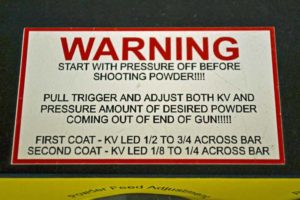 I will talk more about this when we get into the process, but voltage actually works the opposite of what you might think. As the number of coats goes up, you REDUCE the amount of voltage at the gun. I have never been at a 100KV setting. A gun capable of 60 KV will most likely be all you ever need. In general, you want to use as little voltage as possible to get the powder to be attracted to the object you are coating.
I will talk more about this when we get into the process, but voltage actually works the opposite of what you might think. As the number of coats goes up, you REDUCE the amount of voltage at the gun. I have never been at a 100KV setting. A gun capable of 60 KV will most likely be all you ever need. In general, you want to use as little voltage as possible to get the powder to be attracted to the object you are coating.
I used to paint in the room that I now use for applying powder coat. It is set up with ventilation through filters. Note the overhead beam where I have attached clamps and ground wires.
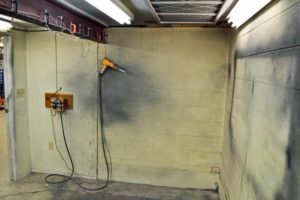 I hang the items to be coated from the clamps and the ground wires are used to ground the items to be coated. I have lots of light so I can see what I am doing. If you wear glasses, you will have to stop every now and then to clean them as the powder gets attracted to them. Unwanted powder can be blown off with an air gun.
I hang the items to be coated from the clamps and the ground wires are used to ground the items to be coated. I have lots of light so I can see what I am doing. If you wear glasses, you will have to stop every now and then to clean them as the powder gets attracted to them. Unwanted powder can be blown off with an air gun.
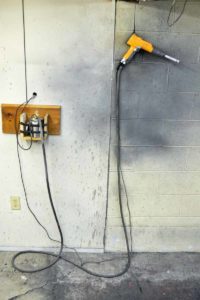 On this wall is a shelf that I put my remote hopper (quart paint cans) and the gun is hung from the beam. There is a control wire that comes through the wall from the control unit to the gun and there is also a feed hose running from the hopper to the gun. What looks like a line running up the wall above the hopper is the ground line from the control unit. It runs along the beam and has separate wires for each clamp with an alligator clip on the end to ground the pieces to be powder coated.
On this wall is a shelf that I put my remote hopper (quart paint cans) and the gun is hung from the beam. There is a control wire that comes through the wall from the control unit to the gun and there is also a feed hose running from the hopper to the gun. What looks like a line running up the wall above the hopper is the ground line from the control unit. It runs along the beam and has separate wires for each clamp with an alligator clip on the end to ground the pieces to be powder coated.
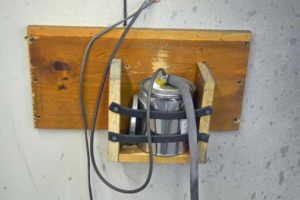 This is a closer view of the remote hopper. The top remains attached to the wall and the cans with different colors can be changed out. If you look closely, you can see where I hot glued the original hopper top to the paint can top. The small hose into the top of the can is air flowing from the control unit. It is used to “liquefy” the power and that flows though the larger hose to the gun.
This is a closer view of the remote hopper. The top remains attached to the wall and the cans with different colors can be changed out. If you look closely, you can see where I hot glued the original hopper top to the paint can top. The small hose into the top of the can is air flowing from the control unit. It is used to “liquefy” the power and that flows though the larger hose to the gun.
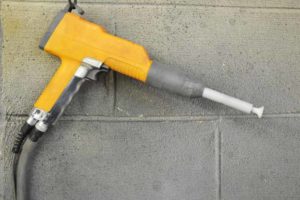 The gun is very similar looking to the gun pictured earlier except there is no attached hopper and, in its place, is a hose that runs to the remote hopper.
The gun is very similar looking to the gun pictured earlier except there is no attached hopper and, in its place, is a hose that runs to the remote hopper.
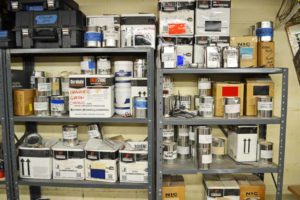 This is the stock of powder I have on hand. I buy in ten pound quantities from Prismatic Powders. http://www.prismaticpowders.com/ They also sell in a one pound quantity, but buying in larger quantities brings the price per pound down. Their color selection is almost limitless. Note that each box has a quart can associated with it. The paint cans seal tightly and keeps moisture out. This setup makes color changes much easier and the powder has a much longer self-life.
This is the stock of powder I have on hand. I buy in ten pound quantities from Prismatic Powders. http://www.prismaticpowders.com/ They also sell in a one pound quantity, but buying in larger quantities brings the price per pound down. Their color selection is almost limitless. Note that each box has a quart can associated with it. The paint cans seal tightly and keeps moisture out. This setup makes color changes much easier and the powder has a much longer self-life.
